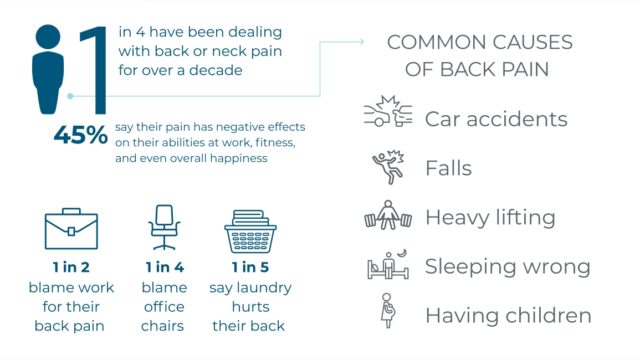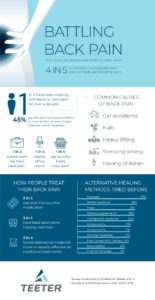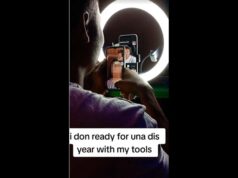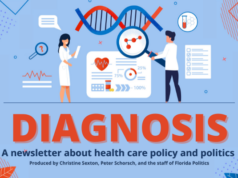
One in four Americans has suffered for more than half a decade with neck or back pain, according to new research.
A study examining the source of people’s back and neck problems and their methods for managing the pain found four in five Americans have experienced back or neck pain at some point, with 16 percent enduring over ten years’ worth of discomfort.
Whether it originated from a car accident, fall, lifting something wrongly, pregnancy, or simply sleeping in a funny position ‒ seven in ten experiencing back or neck pain said their discomfort interfered with their day-to-day activities.
Shockingly, 56 percent of back and neck pain sufferers feel their work environment actually aggravates their aches and pains.
The survey of 2,000 Americans was conducted by OnePoll on behalf of Teeter, and provided insight on the various triggers for back and neck pain as well as the approaches people take to try to relieve it.
So, what are people doing that’s putting their back on the brink? Results showed that in those who have had back and neck problems, heavy lifting (57 percent), sitting too long (51 percent), bending over (45 percent), and poor mattresses all ranked high on a list of pain aggravators.
One in four blamed office chairs for triggering spasms while one in five admitted that doing laundry can exacerbate their back or neck pain. Routine daily tasks such as carrying groceries, taking the stairs, and driving can spark discomfort as well with 25 percent reporting the pain lasted longer than a week.
Forty-five percent of sufferers reported their pain has resulted in negative effects on their abilities at work, fitness, and even overall happiness.
With so many possible ways for someone to irritate their back or neck, people have searched far and wide for the perfect remedy. Three in five Americans who’ve had back and neck aches use over-the-counter pain relievers to manage their discomfort while 45 percent have a prescription from their doctor.

Three in five have tried home remedies or alternative healing methods for back and neck discomfort — and people over 55 are particularly interested in non-traditional healing techniques since one in two are aiming to be as natural as possible.
A spokesperson from Teeter said: “So many traditional back pain options only address the symptoms – and that’s just not a sustainable solution. Targeting the root cause is really the only way to stop the cycle of chronic back pain. We hear from countless people who have tried every traditional method with little to no relief, who think they’ll just have to accept the pain as part of their lives, because they haven’t found the right solution yet.”
For those searching for relief via home remedies, being “as natural as possible” was vital for one in two people. Two in five also found traditional methods ineffective, which led them to look at more alternative healing techniques.
That didn’t come as a surprise seeing as one three in four found alternative medicine more or equally effective as traditional treatments.
A clear sign the times have changed is in the way people go to find information for treatment options — 56 percent go to their doctor, but 54 percent go to the Internet.
For those who’ve tried alternative healing, the most popular methods included: massages, herbal medicine, yoga, and inversion therapy.
The Teeter spokesperson added:
“People don’t want to keep masking their pain with drugs, and they see surgery as a last-resort option, so they’re starting to explore alternative medicine to try to get to the root of the problem. There are natural home solutions, like using a Teeter inversion table, that are still unfamiliar to a lot of people but have proven time and time again to offer more effective relief from stubborn back and neck pain than traditional medicine.”
HOW PEOPLE MANAGE BACK/NECK PAIN
Over the counter pain relievers 64%
Prescribed pain relievers 45%
Physical therapy 38%
Alternative healing/home remedies 37%
Chiropractic care 24%
Surgical solutions 11%
WHAT’S AGGRAVATED BACK/NECK PAIN
Heavy lifting 57%
Sitting for too long 51%
Bending over 45%
Standing or walking too long 42%
Poor mattress 28%
Carrying groceries 28%
Bad office chairs 26%
Driving 23%
Stairs 23%
Laundry 22%
Mowing the lawn 17%
REASONS TO EXPLORE ALTERNATIVE HEALING/HOME REMEDIES
Want to be as natural as possible 51%
Traditional methods were ineffective 40%
Can’t afford other treatments 32%
Chemical drugs make me sick 27%
Don’t have time for doctors or physical therapy 18%
ALTERNATIVE HEALING METHODS TRIED BEFORE
Massage 56%
Herbal medicine 36%
Yoga 31%
Dietary supplements 26%
Chiropractic/osteopathic medicine 24%
Homeopathy 19%
Acupuncture 17%
Chinese/oriental medicine 17%
Electromagnetic therapy 14%
Naturopathy 12%
Inversion therapy 11%












